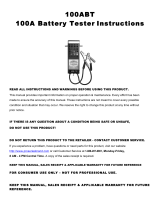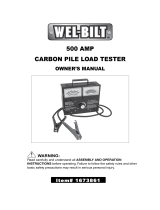
50 AMP LOAD50 AMP LOAD
50 AMP LOAD50 AMP LOAD
50 AMP LOAD
BABA
BABA
BA
TTERTTER
TTERTTER
TTER
Y AND CHARGINGY AND CHARGING
Y AND CHARGINGY AND CHARGING
Y AND CHARGING
SYSTEM TESTERSYSTEM TESTER
SYSTEM TESTERSYSTEM TESTER
SYSTEM TESTER
OPERATING INSTRUCTIONS
3491 MISSION OAKS BLVD., CAMARILLO, CA 93011
VISIT OUR WEB SITE AT HTTP://WWW.HARBORFREIGHT.COM
Copyright
©
2003 by Harbor Freight Tools
®
. All rights reserved. No portion
of this manual or any artwork contained herein may be reproduced in any
shape or form without the express written consent of Harbor Freight Tools.
For technical questions and replacement parts, please call 1-800-444-3353
®
90893

SKU 90893 Page 2
Save This Manual
You will need the manual for the safety warnings and precautions, operating and
maintenance procedures. Keep your invoice with this manual in a safe and dry
place for future reference.
SAFETY PRECAUTIONS
WARNING!
READ AND UNDERSTAND ALL INSTRUCTIONS. Failure to follow all instruc-
tions listed below may result in electric shock, fire, and/or serious injury.
SAVE THESE INSTRUCTIONS
1. Keep your work area clean and well lit. Cluttered benches and dark areas invite
accidents.
2. Do not operate power tools in explosive atmospheres, such as in the presence
of flammable liquids, gases, or dust. Power tools create sparks which may
ignite the dust or fumes.
3. Keep bystanders, children, and visitors away while operating a power tool.
Distractions can cause you to lose control. Protect others in the work area from
debris such as chips and sparks. Provide barriers or shields as needed.
4. Do not force the tool. Use the correct tool for your application. The correct tool
will do the job better and safer at the rate for which it is designed.
5. Do not use the power tool if the Power Switch does not turn it on or off. Any tool
that cannot be controlled with the Power Switch is dangerous and must be
replaced.
6. Store idle tools out of reach of children and other untrained persons. Tools are
dangerous in the hands of untrained users.
metI noitpircseD
ytilibapaC
gnigrahchtiwretsetyrettabCDV21dna6
tuptuometsys
yticapaCtseTdaoL sPMAgniknarcdloc005-003;sPMA05
reteMyalpsiD )mumixam(CDV61-0,golanA
elcyCtseT
;nwodloocetunim1htiwtsetrepsdnoces01
setunim5nistset3otpu
spmalC/selbaCyrettaB spmalcdetalp-reppoC;"51
snoisnemiDllarevO -21
1
/
2
-6xL"
1
/
4
D"3xW"
serutaeF teefrebburruofdnaeldnahgniyrraC
SPECIFICATIONS
REV 03/04

SKU 90893 Page 3
7. Maintain tools with care. Keep clean. Do not use a damaged tool. Tag damaged
tools “Do not use” until repaired.
8. Tool service must be performed only by qualified repair personnel. Service or
maintenance performed by unqualified personnel could result in a risk of injury.
9. Maintain labels and nameplates on this
tool. These carry important information.
If unreadable or missing, contact Harbor
Freight Tools for a replacement.
10. Always wear ANSI approved safety
impact eye goggles and heavy work
gloves when using this tool. Using
personal safety devices reduce the risk
for injury. Safety impact eye goggles and
heavy work gloves are available from
Harbor Freight Tools.
11. Maintain a safe working environment. Keep the work area well lit. Make sure
there is adequate surrounding workspace. Always keep the work area free of
obstructions, grease, oil, trash, and other debris. Do not use this tool in areas
near flammable chemicals, dusts, and vapors. Do not use this product in a
damp or wet location.
WARNING! People with pacemakers should consult their physician(s) before
using this product. Operation of electrical equipment in close proximity to a
heart pacemaker could cause interference or failure of the pacemaker.
SPECIFIC SAFETY RULES FOR THE BATTERY TESTER
1. When connecting the Battery Cables to the battery, avoid creating sparks (always
connect and disconnect clamps exactly as described in rule number 2, below,
and on page 4), especially when the battery is being charged. Explosive gases
are created during charging. Sparking could also damage the vehicle electrical
system.
2. Be certain of the test battery polarity before connecting the test Cable Clamps.
The red Cable Clamp (A) goes to the positive terminal of the battery. The black
Cable Clamp (B) goes to the negative terminal of the battery.
3. When placing the Battery Tester in the vehicle (on the frame, engine, or fender),
take special care that the metal housing of the Battery Tester does not come in
contact with either terminal of the battery or other electrical connections.
4. Do not drop the Battery Tester as it may affect proper operation.
5. Do not smoke or have open flames near the battery.
Battery acid may cause severe
injury to eyes; always wear ANSI
approved safety goggles. Avoid
touching eyes while working with or
near a battery. In case of accidental
contact, rinse eyes with clean water
for at least 5 minutes and see a
doctor immediately.

SKU 90893 Page 4
6. Reversing Battery Tester Cable Clamps on the battery will damage the tester.
7. Do not connect the Battery Tester to the battery while the battery is being charged.
Turn the engine off before connecting.
8. Do not touch the cooling vents on the Battery Tester immediately after testing
the battery. They become very hot.
UNPACKING
When unpacking, check to make sure that all the parts are included.
Refer to the Assembly Diagram, Below.
If any parts are missing or broken, please call Harbor Freight Tools
at the number on the cover of this manual as soon as possible.
OPERATING INSTRUCTIONS
Testing the Battery
Undercharged lead-acid batteries will freeze during cold weather.
NEVER TEST OR CHARGE A FROZEN BATTERY.
1. To help ensure a good connection, clean battery terminals with a solution of
baking soda and water, and wipe the battery terminals with a cloth to remove
any dirt and grease.
2. Connect the red (positive) Cable Clamp (A) to the positive terminal (+) on the 6
or 12 V lead-acid battery. (See photo above.)
3. Connect the black (negative) Cable Clamp (B) to the negative terminal (–) on the
battery. Turn clamps slightly to ensure a good connection.
4. With the clamps connected, the tester’s gauge will show the battery’s current
charge. If it is less than 12 V on a 12 V battery (or 6 V on a 6 V battery),
disconnect the battery and recharge before testing. If recharging will not bring
the reading above the appropriate voltage (noted above), the battery is defective.
If it shows no reading, verify that the tester is connected properly. If the tester
is connected properly, the battery is defective.
(A)
(B)
(C)
(D)

SKU 90893 Page 5
5. Press (and hold) the Toggle Switch (C) for at least 5 seconds to simulate an
actual load on the battery.
6. View the Meter Display (D) and read the battery condition. Refer to the “Battery
Condition Analysis” section below.
7. Release the Toggle Switch (C) and remove the Cable Clamps from the battery.
Testing the Charging System
Note: The engine should be at normal operating temperature during this test.
1. Connect the Cable Clamps (A, B) to the battery as previously described.
2. Outside, or in a well ventilated area, start the vehicle engine and run at fast idle
speed. Never start and run the vehicle’s engine in a closed garage.
Avoid Carbon Monoxide poisoning. This gas comes
from the vehicle exhaust and is colorless and odorless. It can
cause serious injury or death if inhaled. Never run the vehicle’s
engine inside a garage or any other enclosed space.
3. View the Meter Display (D) and read the charging system condition (far right on
the gauge). Refer to the “Battery Condition Analysis” section below.
Caution: DO NOT press the Toggle Switch (C) during this test.
Battery Condition Analysis
.ceS5/TSETDAOL
)gnidaeRyalpsiD(
NOITIDNOCYRETTAB
KO
)aeraneerg(
ehtgnitsetybetatsegrahcehtkcehC.degrahcyllufebtonyamroyaM.doogsiyticapacyrettaB
gnigrahcelbissoprofkcehc,egrahcllufnahtsselsiGSfI.retemordyHahtiw)GS(ytivarGcificepS
.levelllufotegrahceR.elbuortmetsys
KAEW
)aerawolley(
roevitcefedebyamyrettaB.doogtonsiyticapacyrettabeht,ydaetssieldeenreteMyalpsiDehtfI
yrettabegrahcer,522.1wolebfI.evitcefedsiyrettabeht,522.1revofI.GSkcehC.degrahcsidyltrap
yamllecralucitrapa,)520.0(stniop2revosllecneewtebGSniecnereffidasierehtfI.tset-erdna
ro,detaflusrehtiesiyrettabneht,levelegrahcllufotGSgnirbtonseodgnigrahcfI.degamadeb
.lairetamevitcastitsolsah
DAB
)aerader(
,kcehckciuqaroF.llecdabasahroevitcefedsiyrettabeht,gnillafsieldeenreteMyalpsiDehtfI
llufstiotsrevoceregatlovfI.noitcaerreteMyalpsiDetondnahctiwSelggoTdaolehtesaeler
,ylwolssrevoceregatlovehtfI.evitcefedylbaborpsiyrettabeht,sdnoceswefaylnoretfalaitnetop
.tset-erdna,egrahcer,GSkcehC.nwodnurebylnoyamyrettabeht
METSYSGNIGRAHC
)aeraetihw(
hgihroderwolehtnosllaftifI.lanoitcnufsimetsysgnigrahc,KOsdaereldeenreteMyalpsiDehtfI
.gninoitcnuflamebyammetsysgnigrahc,saerader
When testing
a 6 V battery,
refer to this
area of the
gauge.
When testing
a 12 V battery,
refer to this
area of the
gauge.

SKU 90893 Page 6
Testing the Starter
Note: The engine should be at normal operating temperature and the battery
should be fully charged before doing this test.
1. Connect the Cable Clamps (A, B) to the battery as previously described.
2. Disable the ignition so the engine will not start. (Refer to your vehicle’s manual.)
3. Have an assistant crank the engine. Note the voltage reading during cranking.
3. View the Meter Display (D) and read the voltage. A reading of 9 volts or less
indicates excessive current draw for a 12 V system. This may be due to a poor
connection, a failing starter, or a battery of insufficient size for the motor.
Caution: DO NOT press the Toggle Switch (C) during this test.
INSPECTION, MAINTENANCE, AND CLEANING
1. Periodically recheck all nuts, bolts, and screws for tightness.
2. Store in a clean and dry location.
3. Clean the outside of the unit with a damp cloth. Never use solvents to clean any
part of this tool. Use compressed air to blow out debris from the load vents.
4. After each use, clean the Cable Clamps of any possible battery electrolyte.
Apply a thin coat of silicon grease to prevent corrosion.
REPLACEABLE PARTS
The Battery Tester has no replaceable parts.
PLEASE READ THE FOLLOWING CAREFULLY
THE MANUFACTURER AND/OR DISTRIBUTOR HAS PROVIDED THE PARTS
DIAGRAM IN THIS MANUAL AS A REFERENCE TOOL ONLY. NEITHER THE
MANUFACTURER NOR DISTRIBUTOR MAKES ANY REPRESENTATION OR WAR-
RANTY OF ANY KIND TO THE BUYER THAT HE OR SHE IS QUALIFIED TO
MAKE ANY REPAIRS TO THE PRODUCT OR THAT HE OR SHE IS QUALIFIED
TO REPLACE ANY PARTS OF THE PRODUCT. IN FACT, THE MANUFACTURER
AND/OR DISTRIBUTOR EXPRESSLY STATES THAT ALL REPAIRS AND PARTS
REPLACEMENTS SHOULD BE UNDERTAKEN BY CERTIFIED AND LICENSED
TECHNICIANS AND NOT BY THE BUYER. THE BUYER ASSUMES ALL RISK
AND LIABILITY ARISING OUT OF HIS OR HER REPAIRS TO THE ORIGINAL
PRODUCT OR REPLACEMENT PARTS THERETO, OR ARISING OUT OF HIS
OR HER INSTALLATION OF REPLACEMENT PARTS THERETO.
-
 1
1
-
 2
2
-
 3
3
-
 4
4
-
 5
5
-
 6
6
Harbor Freight Tools 90893 User manual
- Type
- User manual
- This manual is also suitable for
Ask a question and I''ll find the answer in the document
Finding information in a document is now easier with AI
Related papers
-
Chicago Electric 93784 User manual
-
Harbor Freight Tools 98480 User manual
-
Harbor Freight Tools 98480 User manual
-
CEN-TECH 6/12V Owner's manual
-
Chicago Electric 91129 User manual
-
Harbor Freight Tools 94088 User manual
-
Chicago Electric 45005 User manual
-
Chicago Electric 03418 User manual
-
Harbor Freight Tools Circuit Tester Set 3 Pc User manual
-
Drill Master 90374 User manual
Other documents
-
Stalwart HW6000014 User manual
-
 Pro-Series by Buffalo Tools 550504 User manual
Pro-Series by Buffalo Tools 550504 User manual
-
Chicago Electric 90636 User manual
-
CHICAGO 66834 Operating instructions
-
 Wel-Bilt Please see replacement item# 37805. 500 Amp Battery/Carbon Pile Tester Owner's manual
Wel-Bilt Please see replacement item# 37805. 500 Amp Battery/Carbon Pile Tester Owner's manual
-
CEN-TECH 92903 Assembly And Operating Instructions Manual
-
CEN-TECH Item 61747-UPC 193175054432 Owner's manual
-
CEN-TECH 61747 Owner's manual
-
CEN-TECH 91129 User manual
-
CEN-TECH Item 69888 Owner's manual







